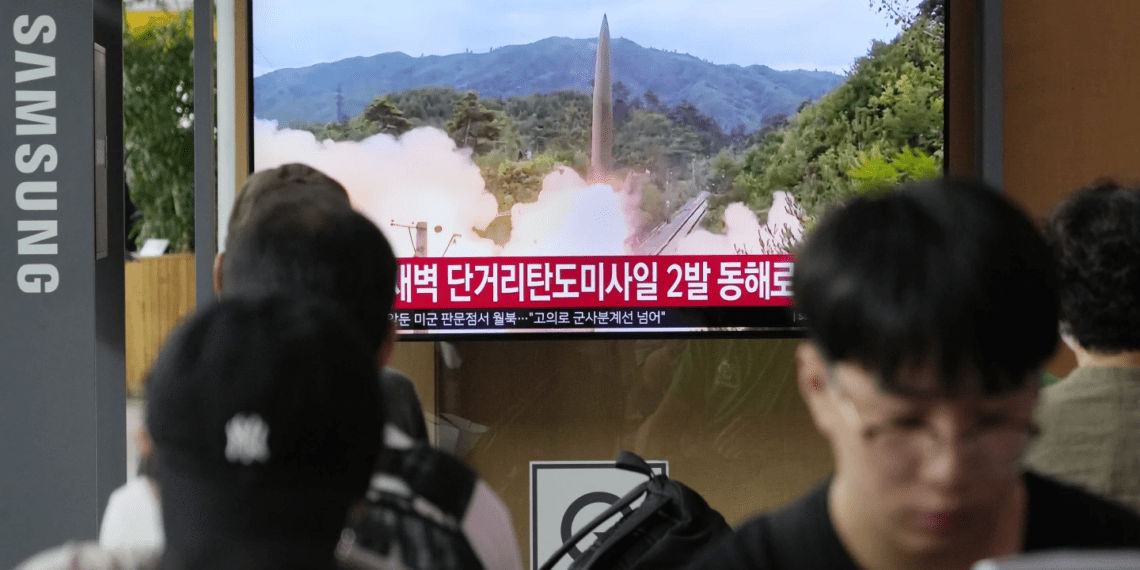In retaliation to the United States’ deployment of a nuclear-armed submarine to South Korea, North Korea launched two short-range ballistic missiles into its eastern sea on Wednesday, July 19, 2023.
U.S deployed the USS Kentucky, a nuclear-armed submarine to South Korea on Tuesday, July 18, 2023, the first in forty years.
South Korean Defense Minister, Lee Jong-Sup opined on Tuesday that the submarine’s visit “shows the allies’ overwhelming capability and posture against North Korea.”
South Korea’s Joint Chiefs of Staff disclosed on Wednesday that from 3:30 to 3:46 a.m. North Korea fired two short-range ballistic missiles from an area near its capital city, Pyongyang that flew about 550 kilometers (341 miles) before landing in waters east of the Korean Peninsula.
Those flight details were similar to the assessment of the Japanese military, which said the missiles landed outside Japan’s exclusive economic zone and that there were no immediate reports of damage from ships or aircraft in affected areas.
The flight distance of the North Korean missiles roughly matched the distance between Pyongyang and the South Korean port city of Busan, where the USS Kentucky arrived on Tuesday.
Also, Japanese Defense Minister, Yasukazu Hamada told reporters that the North Korean missiles traveled on a low trajectory, with their maximum altitude reaching about 50 kilometers (31 miles), and possibly demonstrated “irregular maneuver” in flight.
Japan has previously used similar language to describe the flight characteristics of a North Korean weapon modeled after Russia’s Iskander missile, which travels at low altitudes and is designed to be maneuverable in flight to improve its chances of evading missile defenses.
Meanwhile, The South Korean Joint Chiefs of Staff condemned the North Korean launches.
“We strongly condemn North Korea’s successive ballistic missile launches as grave provocative acts that undermine the peace and stability of the Korean Peninsula as well as the international community, and are a clear violation of UN Security Council resolutions.”
South Korean Joint Chiefs of Staff
The South Korean and U.S. militaries were closely monitoring the North for further weapons activities, they added.
Tensions have risen in the region in recent months as the pace of both North Korean weapons tests and U.S.-South Korean joint military drills have increased in a retaliatory sequence.
Since the start of 2022, North Korea has test-fired around 100 missiles while attempting to demonstrate a dual ability to conduct nuclear attacks on both South Korea and the continental United States.
The allies in response have stepped up their joint military training and agreed to increase the deployments of U.S. strategic assets like long-range bombers, aircraft carriers and submarines to the region.
Missile Launch Linked To U.S Submarine Deployment
According to Leif-Eric Easley, a Professor of international studies at Ewha University in Seoul, the latest launch had more to do with the arrival of the U.S submarine and the meeting on Washington’s extended deterrence to South Korea.
“As Pyongyang looks to assert its nuclear threats and capabilities over South Korea, it undoubtedly opposes Seoul and Washington’s Nuclear Consultative Group and the visit of a US nuclear ballistic missile submarine,” he said.
U.S. Forces Korea said in a statement that the Kentucky’s arrival in Busan reflects the United States’ “ironclad” commitment to “extended deterrence,” referring to an assurance to defend its ally with its full military capabilities, including nuclear ones.
Also, the U.S military said that it was aware of the missile launches on Wednesday morning and was consulting closely with its allies and partners.
Nonetheless, the US Indo-Pacific Command noted in a statement that the launches did not appear to pose an immediate threat to the U.S or its allies but the events highlight the destabilizing impact of North Korea’s illicit weapons programme.
READ ALSO: Russia To Consider Rejoining Black Sea Grain Deal When It Sees ‘Results’




















